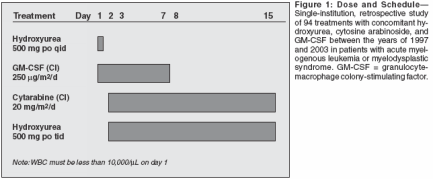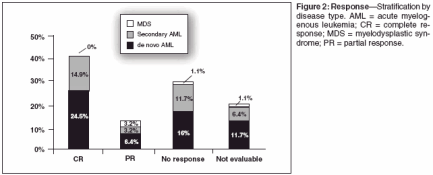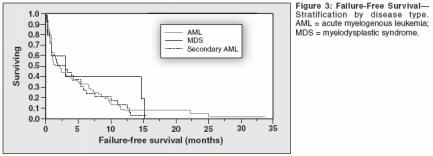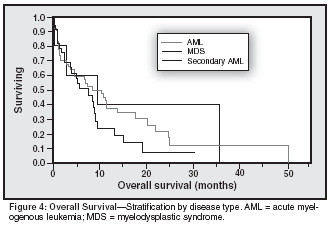GM-CSF and Low-Dose Cytosine Arabinoside in High-Risk, Elderly Patients With AML or MDS
Priming of leukemic cells with cytokines may enhance the efficacy of cell-cycle chemotherapy. In this study, we utilized these synergistic effects of granulocyte-macrophage colony-stimulating factor (GM-CSF, sargramostim [Leukine]), hydroxyurea, and low-dose cytosine arabinoside to treat elderly patients with acute myelogenous leukemia (AML) or myelodysplastic syndrome (MDS). In a single-institution, retrospective study, we evaluated 94 treatments with concomitant hydroxyurea, cytosine arabinoside, and GM-CSF between the years of 1997 and 2003 in high-risk elderly patients with AML or MDS. A total of 80% of patients received all of the GM-CSF doses; 78% of patients received all of the cytosine arabinoside doses. Adverse events were minimal. No patient developed mucositis or alopecia. The most common adverse event was neutropenic fever, which was noted in 57% of patients. Twenty-one percent of patients remained neutropenic after treatment until death or relapse. Sixty-eight percent of patients reached an absolute neutrophil count of greater than 1,000 μL in a median of 33.5 days. Our data show an overall response rate of 52%, with a complete response rate of 39% and a partial response rate of 13%. Overall, our study showed that low-dose cytosine arabinoside given by continuous infusion together with continuous infusion GM-CSF and hydroxyurea was well-tolerated and effective in treating elderly AML and MDS patients who were not eligible for standard induction therapy.
Priming of leukemic cells with cytokines may enhance the efficacy of cell-cycle chemotherapy. In this study, we utilized these synergistic effects of granulocyte-macrophage colony-stimulating factor (GM-CSF, sargramostim [Leukine]), hydroxyurea, and low-dose cytosine arabinoside to treat elderly patients with acute myelogenous leukemia (AML) or myelodysplastic syndrome (MDS). In a single-institution, retrospective study, we evaluated 94 treatments with concomitant hydroxyurea, cytosine arabinoside, and GM-CSF between the years of 1997 and 2003 in high-risk elderly patients with AML or MDS. A total of 80% of patients received all of the GM-CSF doses; 78% of patients received all of the cytosine arabinoside doses. Adverse events were minimal. No patient developed mucositis or alopecia. The most common adverse event was neutropenic fever, which was noted in 57% of patients. Twenty-one percent of patients remained neutropenic after treatment until death or relapse. Sixty-eight percent of patients reached an absolute neutrophil count of greater than 1,000 μL in a median of 33.5 days. Our data show an overall response rate of 52%, with a complete response rate of 39% and a partial response rate of 13%. Overall, our study showed that low-dose cytosine arabinoside given by continuous infusion together with continuous infusion GM-CSF and hydroxyurea was well-tolerated and effective in treating elderly AML and MDS patients who were not eligible for standard induction therapy.
Treatment of acute myelogenous leukemia (AML) is associated with decreased tolerance and response in elderly patients.[1,2] One mechanism that helps increase the activity of chemotherapy while attempting to minimize toxicity is cytokine priming of leukemic cells, which may enhance the efficacy of cell cycle-directed therapy. Human granulocyte-macrophage colony-stimulating factor (GM-CSF, sargramostim [Leukine]) has been shown to prime the leukemic blasts by increasing the number of cells in S phase and increasing their susceptibility to S-phase agents such as cytosine arabinoside.[ 3] GM-CSF has also been shown to increase the intracellular levels of cytarabine (Ara-CTP), thereby increasing the antileukemic effect of cytosine arabinoside.[3,4] A second mechanism of synergy is the use of hydroxyurea, which also has a synergistic effect with cytosine arabinoside, depleting the intracellular deoxycytidine 5'-triphosphate (dCTP) by inhibiting cytidine triphosphate (CTP) synthesis.[5] In this study, we utilized these synergistic effects of GM-CSF, hydroxyurea, and cytosine arabinoside to treat elderly patients with acute myelogenous leukemia or myelodysplastic syndrome (MDS). The synergy between drugs enabled us to administer a low dose of cytosine arabinoside, minimizing side effects. Patients and Methods In our single-institution, retrospective study, we evaluated 94 treatments with concomitant hydroxyurea, cytosine arabinoside, and GM-CSF between the years of 1997 and 2003 in patients with AML or MDS. Patients offered this treatment were unable to tolerate conventional AML induction chemotherapy. They received induction chemotherapy with GM-CSF at 250 μg/m2/d on days 1 through 7 by continuous infusion and cytosine arabinoside at 20 mg/m2/d on days 2 through 15, also by continuous infusion. Hydroxyurea was given orally at 500 mg four times daily on day 1 and then 500 mg three times daily on days 2 through 15. Prior to treatment, white blood cell count had to be < 10,000/μL (Figure 1).



In our study of 94 patients, the median age of the 37 women (39%) and 57 men (61%) was 68.5 years (range: 22-85 years). Eighty-four percent of patients were over age 60, 45% over 70, and 6% over 80. Fiftyfive patients (59%) were diagnosed with de novo AML, and 34 (36%) with secondary AML. Five patients (5%) were diagnosed with MDS. Comorbidities were either cardiac, pulmonary, or renal: 63% of patients had cardiac comorbidities (either arrhythmia, history of myocardial infarction, or symptomatic congestive heart failure [CHF]), 13% had pulmonary comorbidity, and 6% had renal comorbidity. Sixty-one percent had one comorbidity, 9% had two comorbidities; 30% of patients had no cardiac, pulmonary, or renal comorbidities. In our patient population, 56% of patients were previously untreated, while 44% of patients had received prior treatment. The median number of prior treatments was 2 (range: 1-9). Fifty-four percent had poor-risk cytogenetics, 43% had intermediaterisk cytogenetics, and 3% had goodrisk prognostic cytogenetics. Treatment In our cohort, 80% (n = 76) of patients received all of the GM-CSF doses. Reasons for stopping GM-CSF were allergic reaction, symptomatic capillary leakage, or leukocytosis. Seventy-eight percent of patients received all of the cytosine arabinoside doses. Chemotherapy was well tolerated. Six percent of patients (n = 6) died while receiving treatment. Causes of death were respiratory failure (n = 2), cerebral vascular accident (n = 2), pulmonary embolism (n = 1), and cardiac arrest (n = 1).

Response Our regimen had a total response rate of 52%. The complete response rate was 39% and the partial response rate was 12% (Figure 2). The complete response rate, when stratified for disease, was 24% for de novo AML, 15% for secondary AML, and 0% for MDS. The partial response rates for de novo AML, secondary AML, and MDS were 6.4%, 3.2%, and 3.2%, respectively. Nineteen percent of patients were not evaluable and 29% had no response. The median duration of complete responses for de novo AML was 241 days (range: 28-1,031 days) and the median duration of secondary AML was 170 days (range: 46-461 days). The median overall survival for all patients was 145 days, but was 336 days for those achieving complete response. The 1-year overall survival rate was 33% (Figures 3 and 4). Adverse Events Adverse events among our cohort of patients were minimal. No patient developed mucositis or alopecia. The most common adverse event was neutropenic fever, which was noted in 57% of patients. Twenty-one percent of patients remained neutropenic after treatment until death or relapse. Sixty-eight percent of patients reached an absolute neutrophil count (ANC) of greater than 1,000 μL in a median of 33.5 days. The other most common adverse events were atrial fibrillation (8%), renal insufficiency (8%), respiratory failure (7%), and fungal infections (7%). Causes of death were eventual relapse of disease (50%), organ failure while in complete response (21%), or treatment-related mortality (21%), which we defined as any death that occurred during the hospitalization in which the patient received chemotherapy. Conclusion Overall, our study showed that lowdose cytosine arabinoside given by continuous infusion together with continuous infusion GM-CSF and hydroxyurea was well-tolerated and effective in treating elderly AML and MDS patients who were not eligible for conventional therapy. Our data show an overall response rate of 52%, with a complete response rate of 39% and a partial response rate of 13%. This study compared favorably with previous studies, which report poor tolerance or response to a cytokine- containing regimen.[6-9]. Possible reasons for this may be our administration of a continuous infusion of GM-CSF instead of subcutaneous injections, and the concomitant use of hydroxyurea. Further prospective studies in a multicenter format are needed to confirm these data.
Disclosures:
The authors have no significant financial interest or other relationship with the manufacturers of any products or providers of any service mentioned in this article.
References:
1. Dillman RO, Davis RB, Green MR, et al: A comparative study of two different doses of cytarabine for acute myeloid leukemia: A phase III trial of cancer and leukemia group B. Blood 78:2520-2526, 1991.
2. Mayer RJ, Davis RB, Schiffer CA, et al: Intensive postremission chemotherapy in adults with acute myeloid leukemia. Cancer and Leukemia Group B. N Engl J Med 331:896-903, 1994.
3. Metcalf D: The molecular biology and functions of the granulocyte-macrophage colony-stimulating factors. Blood 67:257-267, 1986.
4. Hiddemann W, Kiehl M, Zuhlsdorf M, et al: Granulocyte-macrophage colony-stimulating factor and interleukin-e enhance the incorporation of cytosine arabinoside into the DNA of leukemic blasts and the cytotoxic effect on clonogenic cells from patients with acute myeloid leukemia. Semin Oncol 19:31-37, 1992.
5. Rauscher F 3rd, Cadman E: Biochemical and cytokinetic modulation of L121 and HL- 60 cells by hydroxyurea and effect on 1-beta- D-arabinofuranosylcytosine metabolism and cytoxicity. Cancer Res 43:2688, 1983.
6. Rowe JM, Neuberg D, Friedenberg W, et al: A phase 3 study of three induction regimens and of priming with GM-CSF in older adults with acute myeloid leukemia: A trial by the Eastern Cooperative Oncology Group. Blood 103:479-485, 2004.
7. Witz F, Sadoun A, Perrin MC, et al: A placebo-controlled study of recombinant human granulocyte-macrophage colony-stimulating factor administered during and after induction treatment for de novo acute myelogenous leukemia in elderly patients. Group Ouest Est Leucemies Aigues Myeloblastiques (GOELAM). Blood 91:2722-2730, 1998.
8. Löwenberg B, Touw IP: Hematopoietic growth factors and their receptors in acute leukemia. Blood 81:281-292, 1993.
9. Zittoun R, Suciu S, Mandelli F, et al: Granulocyte-macrophage colony-stimulating factor associated with induction treatment of acute myelogenous leukemia: A randomized trial by the European Organization for Research and Treatment of Cancer Leukemia Cooperative Group. J Clin Oncol 14:2150-2159, 1996.
Navigating AE Management for Cellular Therapy Across Hematologic Cancers
A panel of clinical pharmacists discussed strategies for mitigating toxicities across different multiple myeloma, lymphoma, and leukemia populations.